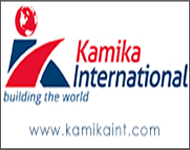 In East Africa's major cities, the skyline is changing. From the ageing buildings, potholed roads and chaotic transport systems, a new order is emerging. New skyscrapers have sprouted and big-ticket transport infrastructure networks are in the works.
In East Africa's major cities, the skyline is changing. From the ageing buildings, potholed roads and chaotic transport systems, a new order is emerging. New skyscrapers have sprouted and big-ticket transport infrastructure networks are in the works.
In Nairobi, East Africa's business and financial hub, a tolled 27km expressway has been launched, giving hope to commuters who have had to endure three-hour drives on the stretch, instead of just 15 minutes.
The Nairobi Expressway from Mlolongo in Machakos County through the Jomo Kenyatta International Airport to the city’s Westlands suburb comes with the promise of easing congestion on the city roads. It is estimated that commuters in Nairobi lose at least Ksh18 billion ($155 million) annually in traffic jams.
"The highway will reduce the rampant traffic jams that are often witnessed on our roads," said President Uhuru Kenyatta last weekend.
This is one of the retiring president’s pet infrastructure projects and part of his legacy.
But it does not come cheap. Users are paying tolls as high as Ksh1,800 ($15.65) and as low as Ksh120 ($1.04).
Its construction cost Ksh87.9 billion ($764 million), according to the Kenya National Highways Authority.
The expressway, with 18.2km on the ground and 8.9km elevated, is a Class A four-lane dual carriageway with a design speed of 80km per hour.
It was constructed and funded by the China Communications Construction Company. It has 11 interchanges at Mlolongo, Standard Gauge Railway, JKIA, Eastern Bypass, Southern Bypass, Capital Centre, Haile Selassie Avenue, Museum Hill, Westlands and James Gichuru Road.
To use the road, motorists are registering to access the Manual Toll Card (MTC) and Electronic Toll Card (ETC). One can also pay in cash.
The government says the project is expected to improve Kenya's competitiveness in the region and entrench Nairobi's position as a business hub.
The other major projects that are changing the skyline and face of the capital include the Green Park Terminal, part of seven out-of-city-centre termini under construction,
bus rapid transport (BRT) corridors, non-motorised transport and light commuter rail.
The construction of the expressway began mid-2020 as a partnership between the government through the Kenya National Highways Authority (KeNHA) and China Roads and Bridge Corporation (CRBC).
Touted as a game-changer in reducing traffic congestion, the project is expected to free up one of the city's main arteries, the A8 road median including Mombasa Road,
Uhuru Highway and Waiyaki Way, as it boasts interchanges, exits and entry routes that will act as toll ramps.
The expressway is expected to serve at least 25,000 vehicles per day.
Then there is the BRT project that is expected to offer a reliable, secure and comfortable system for city residents.
In 2020, Stecol Corporation signed a memorandum to build the BRT system working with Nairobi Metropolitan Area Transport Authority (Namata).
The system comprises a right-of-way lane, coloured pavement, dedicated BRT lane and flyovers as well as 13 intermediate stations.
It will have five lanes, which are in different phases of development.
To complement the BRT system, Transport and Infrastructure Cabinet Secretary James Macharia gazetted a commuter rail network. The BRT and commuter rail will be integrated.
Operations have started in Embakasi, Pipeline and Donholm railway in the city’s eastlands.
The three railway stations are among the 10 stations Kenya Railways has upgraded and constructed.
The government also embarked on major renovations of the Nairobi Commuter Rail Service (NCRS), which is part of Nairobi Metropolitan Transport Master Plan aimed at integrating rail transport with other modes of transport like road and air.
The project has seen the modernisation and expansion of underutilised railway infrastructure. There are 26 new modern passenger-handling stations in Syokimau, Makadara, Imara Daima, Ruiru, JKIA, Kikuyu and Embakasi Village in the city’s outskirts.
As part of the project, the Nairobi Central Station in the city centre has undergone a facelift with designated boarding points.
The Nairobi Metropolitan Services, which was created by the Uhuru Kenyatta administration and put under a military general, Mohamed Badi, has been instrumental in changing the face of the city.
In September 2020, the NMS began relocating public service vehicles and boda-boda cyclists out of the city centre to seven new out-of-city centre termini.
They include Ksh250 million ($2.1 million) Green Park terminus, the Muthurwa and Globe Roundabout termini, Bunyala/Workshop terminus, Desai and Park Road and Fig Tree terminus.
The latter three and Green Park are complete, awaiting commissioning.
"We intend to remove all matatus and boda-bodas from the city centre," said Lt-Gen Badi. "We will build six termini where all matatus and boda-bodas will terminate without entering into the city centre."
The NMS has also been rolling out non-motorised transport (NMT) corridors to provide safe walkways and cycling lanes, to reduce private cars in the CBD. The on-street parking slots that dotted the streets were replaced with cabro walkways and cycling lanes. The Ksh1.4 billion ($12 million) NMT corridors are also being expanded to city estates.
And in Mombasa, Kenya's second-largest city and the gateway to East and Central Africa, the government has prioritised the Mombasa Port Development Project allocating $69 million this financial year. The project features a Freeport and Special Economic Zone, a second container terminal, roads and upgraded rail.
To ensure free movement of cargo from Mombasa to Uganda, Rwanda, South Sudan, Burundi, Somalia, northern Tanzania, and eastern Democratic Republic of Congo, Kenya has invested $380 million in the standard gauge railway to evacuate cargo to the Nairobi Inland Container Depot and Naivasha container depot. To connect to the Malaba border, the metre gauge railway from Naivasha is being linked to the SGR, then to facilitate trucking, the government has invested more in roads and bridges to open up the port city. The projects include the 28km Dongo Kundu highway connecting Miritini and Kwale County, and two bridges costing $28 million.
In the South Coast, a number of projects are playing a major role in boosting tourism. One is Liwatoni footbridge, which has improved ferry operations, motivating tour operators to resume their visits to the South Coast. The Ksh1.9 billion ($16.3 million) footbridge has reduced congestion and eased human and vehicular movement across the Likoni channel, which serves about 350,000 passengers and 7,000 vehicles daily.
The Liwatoni bridge opens daily for pedestrians at 6am and closes at 8am, after which residents are allowed to use the ferry. It opens again between 4pm and 8pm, when a majority of people leave work.
Prominent hotelier Mohammed Hersi said the bridge is important for tourism, adding that the Dongo Kundu project will open up the South Coast, one of the region’s tourist hubs.
"Dongo Kundu will connect Mombasa and Kwale and its location is strategic since it is located next to Moi International Airport," said Mr Hersi.
The case of Dar es Salaam
In Tanzania, the Indian Ocean port city of Dar es Salaam remains the commercial hub and the main focus of urban infrastructural expansion
In the past decade, the sprawling metropolis has registered rapid changes to its skyline. City planners also appear to be struggling to keep up with the pace of transformation, even with the help of a comprehensive Dar es Salaam Master Plan that was adopted with an initial timeline of 2012-2032 and later reset to 2016-2036.
Key developments in recent years include flyovers and bridges linking downtown to upmarket suburbs such as Kigamboni, Oysterbay and Masaki. The projects were initiated by the late John Magufuli to ease traffic congestion.
The Mfugale Overpass was commissioned in 2017 to sort out traffic snarl-ups on the main road to and from the Julius Nyerere International Airport. It was followed in 2020 by the bigger and more elaborate Kijazi Interchange, which has cleared congestion at Ubungo, the main entrance and exit point connecting the seaside city to the hinterland.
The $258.3 million Tanzanite or New Selander Bridge between the CBD and the high-end Oysterbay commercial and residential area was also built by the Magufuli administration. It was completed after his death in March 2021 and launched by his successor Samia Suluhu Hassan in February this year.
Magufuli's 'Bulldozer' nickname was derived from his aggressive focus on infrastructural evolution, and he oversaw the shift of Dar's upcountry bus terminus to a new site outside the CBD to ease traffic jams.
The Dar es Salaam Bus Rapid Transit (BRT) began operations in May 2016. Despite commuter complaints ranging from insufficient buses to high fares, the BRT has done a lot to ease public transport hassle in the city and is credited with the global Sustainable Transport Award Dar was awarded in 2018.
Only Phase I of the BRT, which cost $143 million, is complete. It consists of 29 stations on one main lane out of the city and a single branch-off. Government officials say Phase II will begin later this year after delays attributed to funding hitches, while the original plan to introduce four more BRT by 2035 also remains on course.
The ongoing cross-country standard gauge railway (SGR) project also starts from Dar and, although the initial plan to complete it in five phases up to Mwanza and Kigoma remains unchanged, talks are at an advanced stage to add connections to Rwanda, Burundi and DRC, as part of the East African Railway Master Plan.
Dar's infrastructural development has also triggered a real estate boom. A slew of ambitious projects, mostly funded by pension fund schemes and the state-owned National Housing Corporation as long-term investments, are also back on track to fulfil the demand for decent and affordable public housing and office rental space.
Earlier this month, the NHC secured a Tsh173.9 billion ($75.3 million) loan from the government to complete two of its commercial and residential projects in Dar, which had stalled: The Morocco Square, described as "the largest project in East Africa under one foundation, integrating premium offices, retail mall, apartments and a hotel," and the Kawe 711 Complex, another premium centre.
Amid the city's growing splendour, over two-thirds of Dar’s population still live in unplanned settlements. The Dar es Salaam Master Plan outlines the creation of at least five satellite cities to decongest the capital and bring jobs and services closer to the suburbs, reducing the need for commute to the city. However, progress remains slow.
Kampala's decongestion
In Uganda, the government is executing a 10-year infrastructure development plan that seeks to reduce traffic congestion and improve its flow through the Kampala Metropolitan Area with several new roads. According to Allan Ssempebwa, Uganda National Roads Authority (UNRA) spokesperson, the aim is to reduce the time and cost of travel around is the country’s administrative and commercial capital.
Top of the plan is the 108km Kampala–Jinja Expressway that is expected to cost about $1.4 billion. The road, when complete, will offer a faster travel between Kampala and Jinja, a strategic route on the Northern Corridor.
The other highly anticipated project is the 3.2km Japan-funded Kampala Flyover set to cost $148 million. The project involves the construction of a flyover at Clock Tower, widening of Queens Way, Nsambya and Mukwano roads and improvement of interfacing roads and junctions. It is touted as the solution to the traffic jam and flooding in the area.
Others are the 23km Busega-Mpigi road estimated to cost $153 million, the 32km Kampala-Bombo road, and the 56km Kampala-Busunju road.
Mr Ssempebwa said the choice of expressways is because of their proven efficiency.
The government is expected to roll out an expressway development programme, which will focus on other parts of the country with high traffic, such as Malaba and Mbarara, Mr Ssempebwa said.
Uganda started collecting toll on its roads this year, starting with the Kampala-Entebbe Expressway, a quicker way to the country’s only international airport.
According to the country's Minister of Works and Transport Gen Katumba Wamala, all major expressways will be tolled.
Before rolling out the road tolling, UNRA had projected that it would handle about 13,000 vehicles monthly but more than 30,000 vehicles use it.
According to UNRA, a week after launch, the expressway generated over $70,000, which will be used to maintain the road and repay the $350 million loan from the Exim Bank of China used for its construction. Motorists now pay between $1.4 and $5, depending on the vehicle size.
Rwanda's infrastructure juggernaut
In Rwanda, the government last week launched phase two of the Rwanda Urban Development Project, an infrastructure juggernaut expected to connect Kigali with six other cities and sort out unplanned settlements and flooding. The city targets asphalt roads, pedestrian walkways, storm water drains; street lighting and bus stops in the plan funded by the government, the World Bank and other development partners at a cost of $175.45 million.
Costs
But the expansion has come at a cost to the economies. Moja Expressway, a subsidiary of CRBC, will operate the Nairobi Expressway for 27 years to recoup its investment through toll fees, with 27 toll booths. With the government seeking to raise the national debt, this is likely to be painful to taxpayers. Kenyan MPs have been pushing for a law change to increase the state's borrowing limit to Ksh13 trillion ($115.04 billion) from Ksh9 trillion ($79.64 billion), even as public debt hit Ksh8.02 trillion ($70.97 billion) in December 2021.
In Tanzania, national debt has spiralled recently due to President Samia’s borrowing spree to fund infrastructure projects. This has had some leaders grumbling about a possible debt stress. Dodoma's national debt amounted to $37.57 billion by end of January 2022, an increase of $133.2 million from December 2021 and $6.27 billion from the amount recorded in January 2021.
External debt accounted for 75.4 percent ($28.17 billion) of the national debt stock. data from the Bank of Uganda shows that total public debt stock as at October 2021 stood at Ush73.78 trillion ($20.72 billion) while external debt exposure amounted to $12.78 billion in the period.
Meanwhile Kenya’s Kisumu City is hosting the 9th edition of the Africities Summit in the coming week. The theme of the Summit is ‘The Role of Intermediary Cities of Africa in the implementation of Agenda 2030 of the United Nations and the African Union Agenda 2063’. The event focuses on the fast rate growth of urbanisation in Africa and its implication for public policy in planning for the use of the urban space for humane and sustainable livelihoods with regard to socio-economic problems that already face small and large urban areas in Africa. Kisumu Governor Prof Anyang’ Nyong’o told The EastAfrican that more than 8,000 delegates are expected to converge on the city from May 17 to May 21.
Posted on : 30 Jul,2025
 In East Africa's major cities, the skyline is changing. From the ageing buildings, potholed roads and chaotic transport systems, a new order is emerging. New skyscrapers have sprouted and big-ticket transport infrastructure networks are in the works.
In East Africa's major cities, the skyline is changing. From the ageing buildings, potholed roads and chaotic transport systems, a new order is emerging. New skyscrapers have sprouted and big-ticket transport infrastructure networks are in the works.



















